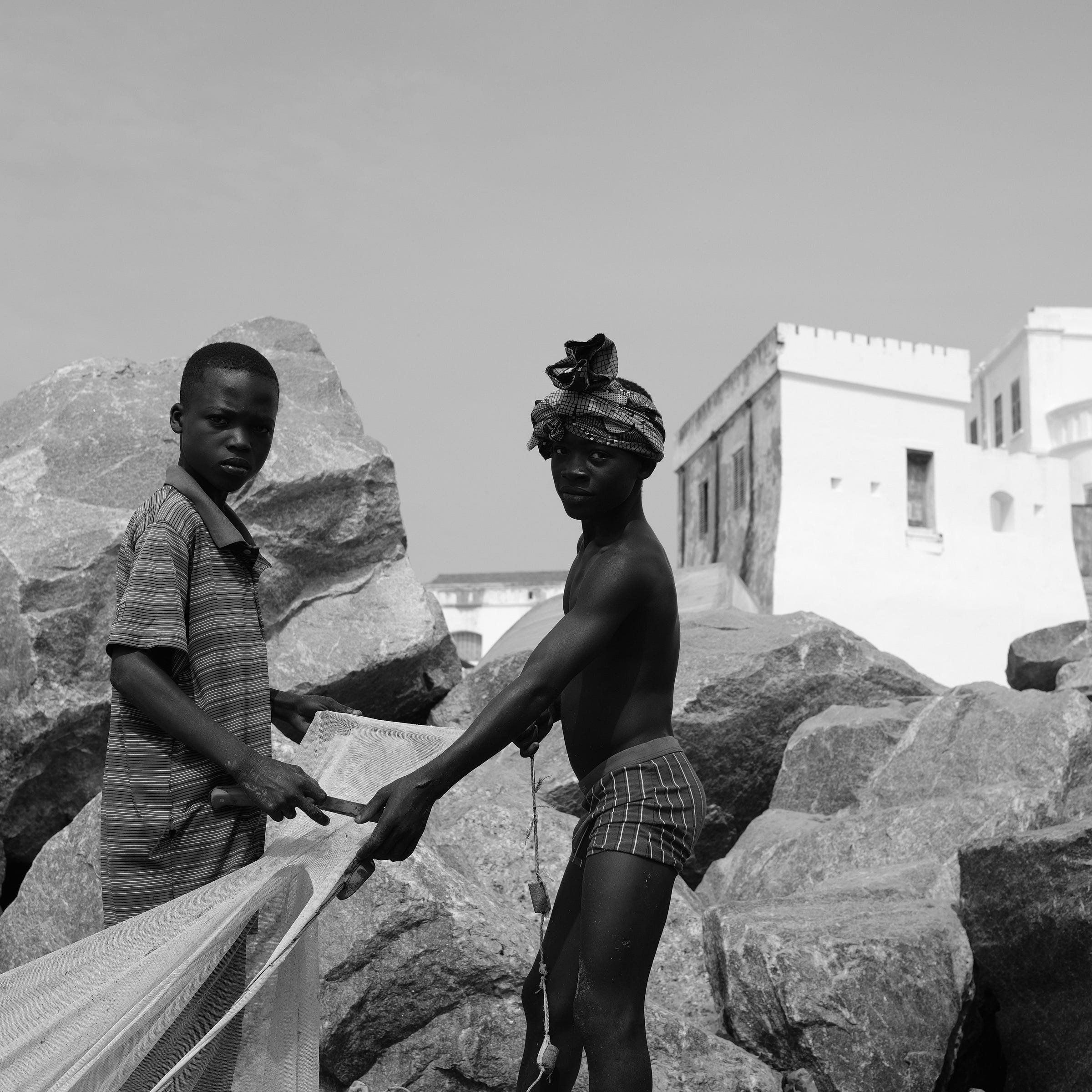When you look at the rocks in contrast with the smooth blackness of the boy’s body—he who stands to the right and has an expression of amusement—the mood of the picture shifts in register from solid to supple. About the other boy, is it possible to notice anything besides his unwelcome glance? Consider the almost-new fade of his hair, the small bulge of a knife pushing out from his hand, and how tightly he holds the net. He carries himself with the gravity of responsibility, as if by turning his back to the white walls he is more attentive to the gains of lowly labour.
— Emmanuel Iduma
“Photography is information and data.”
This photograph was made in Cape Coast, Ghana, close to the Castle where there were slave trade activities. I was on assignment looking at how climate change was affecting forts and castles. While waiting to get in, I decided to take a walk around. The scene of the fishing folks reminded me of photographs of the legendary Ghanaian photographer James Barnor. I wondered how much has changed since James Barnor photographed places like this. I started to make photographs in the black and white square format hoping to put them side by side with Barnor’s photos. Also, since the Castle has received a large number of visitors in recent years due to the “Year of Return,” I wondered how much it has impacted the lives of the people living by the Castle.
This photograph easily communicates what I am trying to achieve with the project idea I am developing: the relationship between the castle and the people that live by it. In the photograph, two boys are taking the weight off a fishing net and they look up at the moment they noticed I was photographing them. Behind them is a sea defence wall and the white Castle.
My approach to photography is surely journalistic and documentary. A lack of information limits us in decision making. Photography is information and data. Photography gives me access to information that I can share. When used in the right way can be very impactful.
— Nipah Dennis
About Nipah Dennis
Nipah Dennis has been working as a photographer for a decade. He works as a full-time photographer pursuing social documentary interests in addition to his practice as a photojournalist working with local and international media organisations. See more of his work on his website, and on Instagram.
Last Week — “Tuesday Afternoon” by Xoliswa Ngwenya
This photograph is a self-portrait from my body of work “Tuesday Afternoon,” where I explore emotions I endured after the passing of my mother when I was 9 years old. This image was taken in the bedroom where she lost her life. I was reminded of the sight of my grandmother and revisited these emotions by wearing my grandmother's gown and my mother’s headwrap. A self-timer and tripod made it possible. My emotions were sincere as I was in a bad place and missing my mother.
SUPPORT TENDER PHOTO
This is the 71st edition of this publication, which also read on web (best for viewing images), and via the Substack iOS/Android apps.
Every Wednesday I feature one photograph and the photographer who took it: you’d read a short caption from me, and a statement from the photographer. Every Saturday I publish a lengthier engagement with photography. Between June 3–July 29, I’m writing a series of micro-essays in response to sequences of photographs previously featured on the newsletter.
Photographers can now submit their work for consideration.
My hope is to engage with early to mid-career African photographers, and to create a platform in which photographers lead the cataloguing and criticism of their work.
Thank you for reading. If this newsletter was shared with you, consider subscribing, or forward to a friend. Please whitelist the newsletter to ensure you never miss it.




This photograph carries so much weight. In the glances of the boys, the carrying of the net, the boulders and the walls of the castle and its colonialist, slave trade history. The stark, glaring whiteness of the castle walls mirror and amplify this. Perhaps I see this in part because I read Yaa Gyasi's novel 'Homegoing', in which the castle and its history figure prominently, devastatingly and poignantly. It is a powerful photograph.
so good